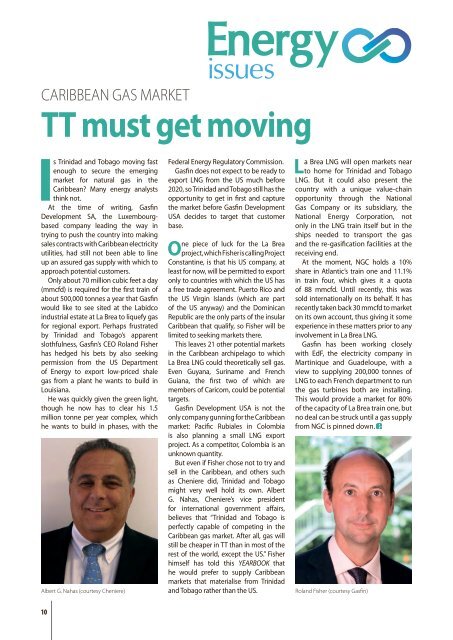ENERGY Caribbean Yearbook (2013-14)
- No tags were found...
You also want an ePaper? Increase the reach of your titles
YUMPU automatically turns print PDFs into web optimized ePapers that Google loves.
caribbean gas market<br />
Energy<br />
issues<br />
TT must get moving<br />
Is Trinidad and Tobago moving fast<br />
enough to secure the emerging<br />
market for natural gas in the<br />
<strong>Caribbean</strong>? Many energy analysts<br />
think not.<br />
At the time of writing, Gasfin<br />
Development SA, the Luxembourgbased<br />
company leading the way in<br />
trying to push the country into making<br />
sales contracts with <strong>Caribbean</strong> electricity<br />
utilities, had still not been able to line<br />
up an assured gas supply with which to<br />
approach potential customers.<br />
Only about 70 million cubic feet a day<br />
(mmcfd) is required for the first train of<br />
about 500,000 tonnes a year that Gasfin<br />
would like to see sited at the Labidco<br />
industrial estate at La Brea to liquefy gas<br />
for regional export. Perhaps frustrated<br />
by Trinidad and Tobago’s apparent<br />
slothfulness, Gasfin’s CEO Roland Fisher<br />
has hedged his bets by also seeking<br />
permission from the US Department<br />
of Energy to export low-priced shale<br />
gas from a plant he wants to build in<br />
Louisiana.<br />
He was quickly given the green light,<br />
though he now has to clear his 1.5<br />
million tonne per year complex, which<br />
he wants to build in phases, with the<br />
Albert G. Nahas (courtesy Cheniere)<br />
Companie<br />
2020, so Trinidad and Tobago still has the<br />
Federal Energy Regulatory Commission.<br />
Gasfin does not expect to be ready to<br />
export LNG from the US much before<br />
opportunity to get in first and capture<br />
the market before Gasfin Development<br />
USA decides to target that customer<br />
base.<br />
One piece of luck for the La Brea<br />
project, which Fisher is calling Project<br />
Constantine, is that his US company, at<br />
least for now, will be permitted to export<br />
only to countries with which the US has<br />
a free trade agreement. Puerto Rico and<br />
the US Virgin Islands (which are part<br />
of the US anyway) and the Dominican<br />
Republic are the only parts of the insular<br />
<strong>Caribbean</strong> that qualify, so Fisher will be<br />
limited to seeking markets there.<br />
Countries<br />
This leaves 21 other potential markets<br />
in the <strong>Caribbean</strong> archipelago to which<br />
La Brea LNG could theoretically sell gas.<br />
Even Guyana, Suriname and French<br />
Guiana, the first two of which are<br />
members of Caricom, could be potential<br />
targets.<br />
Gasfin Development USA is not the<br />
only company gunning for the <strong>Caribbean</strong><br />
market: Pacific Rubiales in Colombia<br />
is also planning a small LNG export<br />
project. As a competitor, Colombia is an<br />
unknown quantity.<br />
But even if Fisher chose not to try and<br />
sell in the <strong>Caribbean</strong>, and others such<br />
as Cheniere did, Trinidad and Tobago<br />
might very well hold its own. Albert<br />
G. Nahas, Cheniere’s vice president<br />
for international government affairs,<br />
believes that “Trinidad and Tobago is<br />
perfectly capable of competing in the<br />
<strong>Caribbean</strong> gas market. After all, gas will<br />
still be cheaper in TT than in most of the<br />
rest of the world, except the US.” Fisher<br />
himself has told this YEARBOOK that<br />
he would prefer to supply <strong>Caribbean</strong><br />
markets that materialise from Trinidad<br />
and Tobago rather than the US.<br />
La Brea LNG will open markets near<br />
to home for Trinidad and Tobago<br />
LNG. But it could also present the<br />
country with a unique value-chain<br />
opportunity through the National<br />
Gas Company or its subsidiary, the<br />
National Energy Corporation, not<br />
only in the LNG train itself but in the<br />
ships needed to transport the gas<br />
and the re-gasification facilities at the<br />
receiving end.<br />
At the moment, NGC holds a 10%<br />
share in Atlantic’s train one and 11.1%<br />
in train four, which gives it a quota<br />
of 88 mmcfd. Until recently, this was<br />
sold internationally on its behalf. It has<br />
recently taken back 30 mmcfd to market<br />
on its own account, thus giving it some<br />
experience in these matters prior to any<br />
involvement in La Brea LNG.<br />
Gasfin has been working closely<br />
with EdF, the electricity company in<br />
Martinique and Guadeloupe, with a<br />
view to supplying 200,000 tonnes of<br />
LNG to each French department to run<br />
the gas turbines both are installing.<br />
This would provide a market for 80%<br />
of the capacity of La Brea train one, but<br />
no deal can be struck until a gas supply<br />
from NGC is pinned down.<br />
Roland Fisher (courtesy Gasfin)<br />
10


















